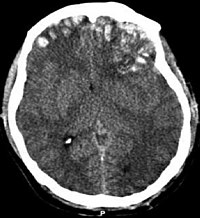
Photo from wikipedia
Study Design Systematic Review. Objectives To determine if individuals with chronic ankle instability (CAI) exhibit maladaptive kinematic and kinetic patterns during dynamic movement tasks. Background Research suggests that high rates… Click to show full abstract
Study Design Systematic Review. Objectives To determine if individuals with chronic ankle instability (CAI) exhibit maladaptive kinematic and kinetic patterns during dynamic movement tasks. Background Research suggests that high rates of recurrent lateral ankle sprain and the development of CAI may be attributable to maladaptive movement patterns that develop following the initial injury. A systematic analysis of these maladaptive movement strategies during dynamic and functional tasks may assist in the development and design of specific rehabilitation programmes. Methods and Measures We searched Pubmed, Embase, CINAHL, SPORTDiscus and Web of Science from origin to December 2016 using the combination of key words including: chronic ankle instability, lower limb, biomechanics and movement or landing. Kinetic and kinematic variables were identified from dynamic movement tasks and grouped into categories including: change of direction, dynamic stability, locomotive and landing tasks. Results Sixty-six articles were included in this review. Despite some contradicting reports, there is clear evidence that measurable differences in kinematic and kinetic variables exist during change of direction, dynamic stability, locomotive and landing tasks in those with CAI. Conclusion Individuals with CAI exhibit aberrant movement profiles when completing dynamic movement tasks; some which may increase their risk of re-injury. As most research focuses on locomotive and landing tasks, future research should include tasks that are more representative of athletic function. Understanding the implications of CAI at this end of the sensorimotor spectrum may help develop a more robust understanding of CAI and improved rehabilitation programmes.
Journal Title: British Journal of Sports Medicine
Year Published: 2017
Link to full text (if available)
Share on Social Media: Sign Up to like & get
recommendations!